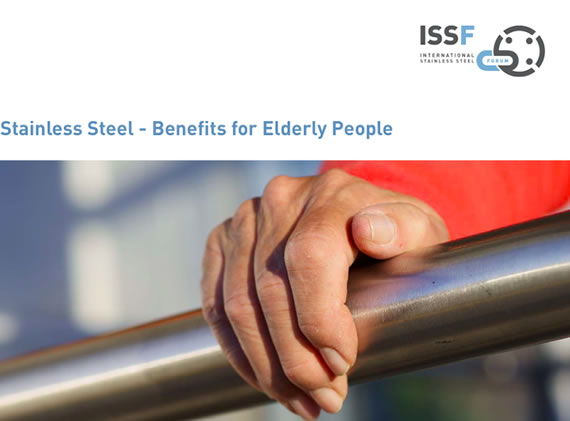Welcome to ‘Stainless Solutions’ from IMOA. Each month, we will cover a different stainless steel issue with tips on design and specification, and links to technical resources. This month’s issue focuses on the ways in which stainless steel is used in design for the elderly and disabled. |
| Designing for the Disabled and Elderly with Stainless Steel |
|
Whether mobility is limited due to disability or aging, it is natural to want to remain independent and mobile. As a society that means making transit and public facilities easily accessible. Residences often need modification for independent living, and both physical therapy and care facilities need to be designed with safety in mind. Products made from stainless steel can be aesthetically pleasing while meeting functional strength, hygienic, and durability requirements.
The ISSF brochure, “Stainless Steel - Benefits for Elderly People”, provides an overview of the many applications where stainless steel is beneficial.
 |
|
Bathroom Design
Safety adjustments often need to be made in bathrooms so that disabled and elderly people can live independently without risk of a fall. Please see the IMOA web page on bathroom design for more information.

Photo credits Signature Hardware (L) and DE-LUNE®
|
|
Interior and Exterior Lifts
Stainless steel is commonly used for interior and exterior lifts because of its strength, corrosion resistance, cleanability, impact resistance and aesthetic appeal. The images below show two types of entrance lifts. Stainless steel is the ideal choice in environments where exposure to salt or pollution needs to be considered.
 |
|
Ramps, Walkways and Safety Railings
Railings should provide a good grip, and consistent structural support, even in corrosive environments. Tubular railings made from embossed stainless steel are particularly helpful in public transit and for safety grips.
Wear, corrosion and slip resistant flooring options include stainless steel tread, corrugated, perforated and etched plate, and gratings. The wear and corrosion resistance of stainless steel provides long term slip resistance for ramps, stair treads, and flooring.
 |
Therapy Pools & Spa Tubs |
 |
IMOA’s website provides design resources for standard pool, therapeutic pool and spa tub design. In “saltwater” pools, where salts (calcium or magnesium chloride, sea salt, treated salt water, etc.) are added to elevate the chloride level above 500 ppm, standard (i.e. Types 316/316L) stainless steel will corrode. Pool liners, ladders, water handling systems, and other parts that will be immersed in the water therefore have to be made of a more corrosion resistant stainless steel for this combination of elevated temperature, chlorination (or bromine) and salt. |
Other common metals like aluminum will corrode even more rapidly when immersed in this type of water. Higher-alloyed stainless steels, designed for exposure to seawater, can be considered for these components but the best alloy choice depends on the specific conditions. The lift above, for example, is not continuously immersed in the pool water.
The most cost effective saltwater pool design is usually stainless steel reinforced concrete with an appropriate plastic liner, since liner leakage can lead to carbon steel reinforcement corrosion and concrete spalling. |
|
Textured Finishes for Slip Resistance
The finish section of IMOA’s website provides guidance on a wide range of stainless steel surface finishes. The brochures that highlight textured surfaces for better grip and slip resistance are covered in these brochures:
Unless otherwise indicated, the images are from the ISSF brochure.
|
| Stainless Steel Library |
|
Download a free Stainless Steel Library (zip file, 735 MB) with over 550 pdfs covering building and construction applications, selection, specification, fabrication, sustainability and other common questions. |
| Stainless Solutions e-newsletter archive |
|
For previous issues or to subscibe to the e-newsletter, please visit the archive page. |
| Continuing Education – American Institute of Architects (AIA) |
|
IMOA is an AIA continuing education system approved provider with eight 1-hour programs that are registered for both live face-to-face and distance learning credit.
1. Stainless Steel Sustainable Design
2. Bioclimatic Design With Stainless Steel Weather Screens
3. Stainless Steel Structural Design
4. Stainless Steel Specification For Corrosive Applications
5. Deicing Salt: Stainless Steel Selection to Avoid Corrosion
6. Stainless Steel Finish Specification
7. Advanced Stainless Steel Specification and Problem Avoidance
8. Specification of Stainless Steel Finishes and Grades For Corrosive Applications
9. Planning for Disaster: Material Selection for More Resilient Design
For more information or to schedule a workshop contact Catherine Houska, 412-369-0377 or email chouska@tmr-inc.com. |
| What is IMOA? |
|
IMOA (International Molybdenum Association) is a non-profit industry association, which provides technical information to assist with successful specification of molybdenum-containing materials. Molybdenum is an element. When it is added to stainless steel, molybdenum increases its resistance to corrosion caused by deicing salts, coastal atmosphere and pollution.
If you have a topic suggestion for a future issue of Stainless Solutions or need additional technical advice on stainless steel specification and selection, please get in touch here.
Forwarded by a colleague? To receive the next issue of Stainless Solutions automatically, please go to our archive and subscription page.
 
|
| Disclaimer |
|
In providing consultation or other assistance with respect to technical issues, any consultation, assistance or material is provided for the general information of the recipient and should not be used or relied upon for any specific application without first securing competent advice. IMOA and their respective employees, consultants and members (i) make no representation or warranty, express or implied, of any kind with regard to such consultation, assistance or material including no representation or warranty of suitability for any general or specific use; (ii) assume no liability or responsibility of any kind in connection therewith; and (iii) disclaim any and all liability for any claim that arises therefrom. |
|